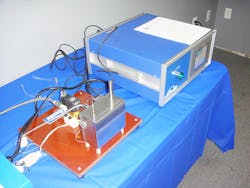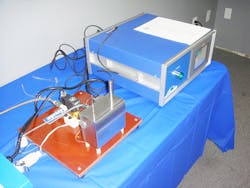Germany's Linde Group brings CO2 mold-cooling technology to U.S.
The Linde Group, Munich, now is offering its liquid carbon dioxide spot mold cooling technology in the United States for temperature control in injection molds. The group is demonstrating the technology at Treo Manufacturing, Troy, Mich., where officials hosted Plastics Machinery Magazine for an exclusive preview in November.
The CO2 is targeted to the cooling of hot spots in the mold via capillary tubes. It is engineered to compete against nitrogen. Liquid CO2 is fed at high pressures through the capillary tubes to the targeted area and the tube ends in a tiny expansion chamber, according to Linde. That CO2 expansion creates a snow and gas mixture with a temperature of -79 degrees Celsius (-110.2 Fahrenheit). Once the heat is removed from the hot steel of the mold, the now gaseous CO2 exits the cavity through open exhaust channels. It is easy to install on a conventional steel tool. The spot cooling can be used on new molds and existing molds can be retrofitted. Officials say that the technology could even help avoid a major mold modification or redesign.
The cryogenic cooling supplements water systems so that surfaces of the mold can be reached that were otherwise difficult. Thicker areas of the mold or areas where materials accumulate are examples. For the molding of a reflector housing, six capillary tubes for CO2 were installed into the mold, said Ed Smith, applications specialist for industrial applications with Linde North America Inc., Murray Hill, N.J. The thermal critical area of the mold was in the middle web where it is not possible to cool with water. It resulted in saved cooling time of 45 percent.
The spot cooling technology is established in Europe, said Rick Stephens, who owns Treo along with Charles Snooks. It has been used for a few years in Europe and now the United States market has become a target growth area.
Treo Manufacturing is hosting the demonstrations at its newly opened Plastics Molding Technical Center in Troy. It is implementing it in its own processes.
"We will be using it when we have a hot drop on a part," said Stephens. "We are going to be spot cooling opposite the hot drop on the cavity. We'll be using the CO2 spot cooling to be able to maintain a surface temperature that eliminates and/or minimizes the Class A surface finish blemish."
There are many benefits to the technology, officials said. This includes shorter cycle times, more uniform cool-ing across the part geometry and mold-release performance. For Stephens, the other benefit is accessing areas that were previously unable to be cooled.
"You can use it in a standard process but you can use it in the micro process," he said.
Angie DeRosa, managing editor

